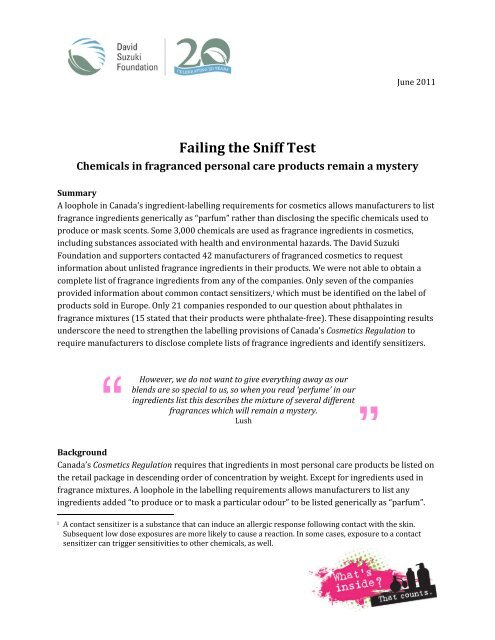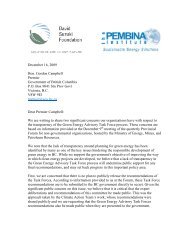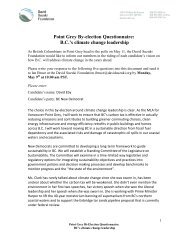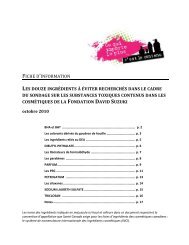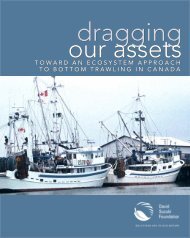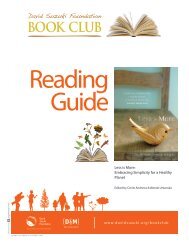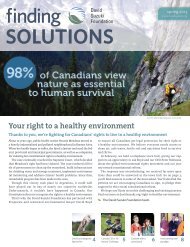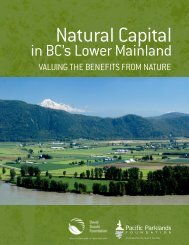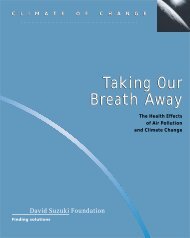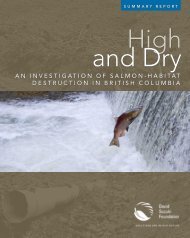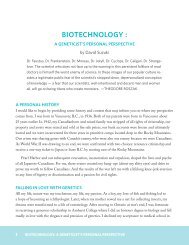Failing the sniff test (PDF) - David Suzuki Foundation
Failing the sniff test (PDF) - David Suzuki Foundation
Failing the sniff test (PDF) - David Suzuki Foundation
Create successful ePaper yourself
Turn your PDF publications into a flip-book with our unique Google optimized e-Paper software.
June 2011<br />
<br />
<strong>Failing</strong> <strong>the</strong> Sniff Test <br />
Chemicals in fragranced personal care products remain a mystery <br />
<br />
Summary <br />
A loophole in Canada’s ingredient‐labelling requirements for cosmetics allows manufacturers to list <br />
fragrance ingredients generically as “parfum” ra<strong>the</strong>r than disclosing <strong>the</strong> specific chemicals used to <br />
produce or mask scents. Some 3,000 chemicals are used as fragrance ingredients in cosmetics, <br />
including substances associated with health and environmental hazards. The <strong>David</strong> <strong>Suzuki</strong> <br />
<strong>Foundation</strong> and supporters contacted 42 manufacturers of fragranced cosmetics to request <br />
information about unlisted fragrance ingredients in <strong>the</strong>ir products. We were not able to obtain a <br />
complete list of fragrance ingredients from any of <strong>the</strong> companies. Only seven of <strong>the</strong> companies <br />
provided information about common contact sensitizers, i which must be identified on <strong>the</strong> label of <br />
products sold in Europe. Only 21 companies responded to our question about phthalates in <br />
fragrance mixtures (15 stated that <strong>the</strong>ir products were phthalate‐free). These disappointing results <br />
underscore <strong>the</strong> need to streng<strong>the</strong>n <strong>the</strong> labelling provisions of Canada’s Cosmetics Regulation to <br />
require manufacturers to disclose complete lists of fragrance ingredients and identify sensitizers. <br />
“<br />
However, we do not want to give everything away as our <br />
blends are so special to us, so when you read ‘perfume’ in our <br />
ingredients list this describes <strong>the</strong> mixture of several different <br />
fragrances which will remain a mystery.<br />
”<br />
Lush <br />
<br />
Background <br />
Canada’s Cosmetics Regulation requires that ingredients in most personal care products be listed on <br />
<strong>the</strong> retail package in descending order of concentration by weight. Except for ingredients used in <br />
fragrance mixtures. A loophole in <strong>the</strong> labelling requirements allows manufacturers to list any <br />
ingredients added “to produce or to mask a particular odour” to be listed generically as “parfum”. <br />
i<br />
A contact sensitizer is a substance that can induce an allergic response following contact with <strong>the</strong> skin. <br />
Subsequent low dose exposures are more likely to cause a reaction. In some cases, exposure to a contact <br />
sensitizer can trigger sensitivities to o<strong>the</strong>r chemicals, as well.
2 <br />
The term parfum may be inserted ei<strong>the</strong>r in order of concentration or at <strong>the</strong> very end of <strong>the</strong> <br />
ingredient list regardless of <strong>the</strong> actual concentration of fragrance ingredients in <strong>the</strong> product. <br />
<br />
Parfum is a very common “ingredient” in cosmetics – not only in perfumes, colognes and <br />
deodorants, but in nearly every type of personal care product. Even products marketed as <br />
“fragrance‐free” or “unscented” may in fact contain fragrance ingredients, in <strong>the</strong> form of masking <br />
agents that block <strong>the</strong> odour of o<strong>the</strong>r ingredients. Some companies use “fragrance‐free” to indicate <br />
that no fragrance chemicals have been added, but this informal industry standard is not enforceable. <br />
Health Canada guidelines treat <strong>the</strong> two terms (fragrancefree and unscented) as equivalent. 1 <br />
“<br />
Most consumer products contain fragrance, and it is an <br />
industry standard for any "Unscented" product to contain <br />
some fragrance. All "Unscented" products contain small <br />
”<br />
amounts of fragrance (usually less than .1%).<br />
Alberto Culver <br />
<br />
There's no way for Canadian consumers to know exactly which chemicals are contained in a product <br />
that lists parfum (or fragrance) as an ingredient. European regulations are stronger. They require <br />
26 contact sensitizers used as fragrance ingredients in cosmetics to be identified on <strong>the</strong> label. That's <br />
a start. <br />
<br />
As many as 3,000 chemicals are used in fragrance mixtures. 2 A single product can include dozens or <br />
even hundreds. Many of <strong>the</strong>se unlisted ingredients are irritants and can trigger allergies, 3 <br />
migraines 4 and asthma symptoms. 5 In laboratory experiments, individual fragrance ingredients <br />
have been associated with cancer 6 and neurotoxicity 7 among o<strong>the</strong>r adverse health effects. Syn<strong>the</strong>tic <br />
musks used in fragrances are of particular concern from an ecological perspective. Environment <br />
Canada has categorized several syn<strong>the</strong>tic musks as persistent, bioaccumulative and/or toxic, and <br />
o<strong>the</strong>rs as priorities for assessment because of human health concerns. Measureable levels of <br />
syn<strong>the</strong>tic musks are found in fish in <strong>the</strong> Great Lakes and <strong>the</strong> levels in sediment are increasing. 8 <br />
Laboratory <strong>test</strong>s of human umbilical‐cord blood commissioned by <strong>the</strong> U.S. Environmental Working <br />
Group detected common syn<strong>the</strong>tic musks (Galaxolide and/or Tonalide) in seven out of 10 newborns <br />
sampled. 9 <br />
<br />
Fragrance or parfum <br />
Parfum is <strong>the</strong> term stipulated in Canada’s Cosmetics Regulation to designate fragrance <br />
ingredients that are not identified individually in ingredient lists. Fragrance is <strong>the</strong> standard term <br />
used in <strong>the</strong> U.S. Often both terms will appear on ingredient lists – e.g., “fragrance/parfum” or <br />
“fragrance (parfum)”. <br />
<br />
<strong>Failing</strong> <strong>the</strong> Sniff Test <br />
www.davidsuzuki.org/publications
3 <br />
Consumers deserve to know about all ingredients contained in cosmetics – including fragrance <br />
chemicals. So <strong>the</strong> <strong>David</strong> <strong>Suzuki</strong> <strong>Foundation</strong>, with <strong>the</strong> help of concerned Canadians, set out to ga<strong>the</strong>r <br />
information from cosmetic companies about <strong>the</strong>ir fragrance formulations. <br />
“<br />
Believe me when I say that I would like nothing better than <br />
to know precisely what ingredients are used to make our <br />
fragrance, but <strong>the</strong> fragrance houses’ right to earn a living <br />
”<br />
has been weighed against our right to know…. <br />
Canus Products <br />
<br />
The <strong>David</strong> <strong>Suzuki</strong> <strong>Foundation</strong>’s Fragrance Challenge <br />
In <strong>the</strong> spring of 2010, <strong>the</strong> <strong>David</strong> <strong>Suzuki</strong> <strong>Foundation</strong> asked Canadians about ingredients in <strong>the</strong>ir <br />
personal care products in an online survey. “Parfum” was by far <strong>the</strong> most commonly reported <br />
ingredient, identified in more than half <strong>the</strong> products with ingredient lists entered in <strong>the</strong> survey. It <br />
was also <strong>the</strong> most commonly reported ingredient in each individual product category, except for <br />
makeup and oral care products. 10 <br />
<br />
With <strong>the</strong> help of <strong>David</strong> <strong>Suzuki</strong> <strong>Foundation</strong> supporters, we contacted 42 manufacturers of fragranced <br />
cosmetics and asked <strong>the</strong>m about <strong>the</strong> fragrance chemicals in specific products that list parfum or <br />
fragrance as an ingredient. <br />
<br />
We asked each company: <br />
1. For a complete list of fragrance ingredients for each product <br />
2. Whe<strong>the</strong>r <strong>the</strong>ir fragrance mixtures contain phthalates <br />
3. Whe<strong>the</strong>r <strong>the</strong>ir fragrance mixtures contain any of <strong>the</strong> 26 sensitizers that must be indicated in <br />
<strong>the</strong> list of ingredients under <strong>the</strong> EU Cosmetics Directive <br />
<br />
<br />
Diethyl phthalate (pronounced tha‐late), or DEP, is widely used in cosmetic fragrances to make <strong>the</strong> <br />
<br />
scent linger. The European Commission on Endocrine Disruption has listed DEP as a Category 1 <br />
priority substance, based on evidence that it may interfere with hormone function. 11 Phthalates <br />
have been linked to reduced sperm count in men and reproductive defects in <strong>the</strong> developing male <br />
fetus (when <strong>the</strong> mo<strong>the</strong>r is exposed during pregnancy), among o<strong>the</strong>r health effects. 12 Phthalate <br />
metabolites are also associated with obesity and insulin resistance in men. 13 As well, Health Canada <br />
notes evidence suggesting that exposure to phthalates may cause liver and kidney failure in young <br />
children when products containing phthalates are sucked or chewed for extended periods. 14 <br />
Phthalates are listed as a Priority and Toxic Pollutant under <strong>the</strong> U.S. Clean Water Act, based on <br />
evidence that <strong>the</strong>y can be toxic to wildlife and <strong>the</strong> environment. 15 Health Canada recently <br />
announced regulations banning six phthalates in children’s toys, but <strong>the</strong> use of DEP in cosmetics is <br />
unrestricted.
4 <br />
The response: <strong>Failing</strong> <strong>the</strong> <strong>sniff</strong> <strong>test</strong> <br />
Table 1 presents a summary of responses from some of Canada’s major cosmetic companies. 34 out <br />
of <strong>the</strong> 42 companies we contacted responded to our inquiry. While a few provided relatively <br />
informative responses, many were clearly form letters that did not address our questions. A very <br />
common response was to refer us to <strong>the</strong> ingredient list on <strong>the</strong> package label and/or company <br />
website. Unfortunately, that doesn’t answer <strong>the</strong> question as only <strong>the</strong> generic term parfum appears <br />
on <strong>the</strong> ingredients list. <br />
<br />
Some companies asked us to call a hotline to discuss <strong>the</strong> questions, only to <strong>the</strong>n tell us by telephone <br />
that <strong>the</strong>y would not disclose information about fragrance ingredients. In some cases, several <br />
consumers contacted <strong>the</strong> same company (or subsidiaries of <strong>the</strong> same parent company) and received <br />
different responses. <br />
<br />
We were not able to obtain a complete list of fragrance ingredients from any of <strong>the</strong> companies we <br />
contacted. Several companies told us <strong>the</strong>ir fragrance mixtures were proprietary – that is, trade <br />
secrets. Some companies suggested <strong>the</strong>y didn’t know exactly which chemicals are used in <strong>the</strong>ir <br />
fragrance mixtures, because <strong>the</strong>y purchase <strong>the</strong>m from third‐party suppliers. <br />
“<br />
The fragrances we use are, in general, obtained from sources <br />
outside <strong>the</strong> company. Their precise formulations, which are <br />
often complex and may include several different ingredients, <br />
are considered confidential information, for competitive <br />
”<br />
reasons within <strong>the</strong> consumer product industry. <br />
Colgate‐Palmolive <br />
Only seven companies consistently provided information about common sensitizers named in <strong>the</strong> <br />
European Union’s Cosmetics Directive (three more companies provided information about <br />
sensitizers to one inquiring consumer, but not to o<strong>the</strong>rs). These 26 fragrance ingredients, which can <br />
cause an allergic reaction in some individuals, must be identified on <strong>the</strong> label of products sold in <br />
Europe. Yet, Canadian consumers rarely have access to this same information – even for products <br />
sold both here and in Europe. Some companies unhelpfully assured us that <strong>the</strong> products <strong>the</strong>y sell in <br />
Europe comply with E.U. regulations, yet declined to provide <strong>the</strong> same information to Canadian <br />
consumers. Only a handful of companies told us <strong>the</strong>y identify <strong>the</strong>se 26 sensitizers in <strong>the</strong> ingredient <br />
lists of <strong>the</strong>ir Canadian product lines – including The Body Shop, Canus Products and Gilchrist & <br />
Soames. The Body Shop stands out for its transparency in this regard: <strong>the</strong>y list each sensitizer <br />
individually and also identify it as a fragrance ingredient. <br />
<br />
Twenty‐one of <strong>the</strong> companies contacted responded to our question about phthalates in fragrance <br />
mixtures (including seven companies that provided this information about some, but not all, of <strong>the</strong> <br />
products in question). Many o<strong>the</strong>rs provided stock statements urging customers not to be <br />
concerned about phthalates in cosmetics, but did not tell us whe<strong>the</strong>r <strong>the</strong> product(s) in question <br />
contained phthalates. Fifteen companies stated that at least some of <strong>the</strong>ir products were phthalatefree. <br />
<strong>Failing</strong> <strong>the</strong> Sniff Test <br />
www.davidsuzuki.org/publications
5 <br />
<br />
Table 1 – Summary of Responses <br />
Response <br />
received <br />
Provided <br />
complete list <br />
of fragrance <br />
ingredients <br />
Provided <br />
information <br />
about <br />
Does fragrance mixture <br />
contain phthalates <br />
(Response may be productspecific) <br />
sensitizers No Yes/Maybe No answer <br />
Alberto Culver * <br />
<br />
Aveda <br />
Avon <br />
Bath & Body Works <br />
Beauti Control <br />
Bio Oil (Advanced Innovations) <br />
The Body Shop (L’Oréal) <br />
Burt's Bees <br />
Canus Products <br />
ColgatePalmolive * <br />
Coty International <br />
La Coupe (Centura Brands) <br />
Fruits & Passion <br />
Gilchrist & Soames <br />
Guelph Soap Company <br />
The Hain Celestial Group † † † † † <br />
Henkel ‡ <br />
Jamieson § § § <br />
Johnson & Johnson * * <br />
Joico <br />
Kao Brands Canada ‡ ** <br />
Kevin Murphy †† <br />
Lise Watier <br />
Live Clean (Belvedere Int.) <br />
Lornamead <br />
Lush <br />
Nature’s Gate <br />
Néolia (Novartis) <br />
6 <br />
<br />
<br />
<br />
Table 1 (cont.)<br />
Response <br />
received <br />
Provided <br />
complete list <br />
of fragrance <br />
ingredients <br />
Provided <br />
information <br />
about <br />
Do fragrance mixtures contain <br />
phthalates (Response may be <br />
specific to a certain product) <br />
sensitizers No Yes/Maybe No answer <br />
Nivea (Beiersdorf) <br />
L'Oreal <br />
Pears <br />
Pierre Fabre <br />
Proctor & Gamble * <br />
Purell (GOJO) <br />
Pureology †† <br />
Radox <br />
REHA Enterprises <br />
Revlon <br />
Sally Hershberger <br />
Unilever * <br />
Woof Cosmetics <br />
Yves Rocher ‡ * <br />
TALLY 34/42 0 7 15 6 21 <br />
* <br />
Most responses from <strong>the</strong>se companies did not specify whe<strong>the</strong>r <strong>the</strong>ir fragrance mixtures contain phthalates; <br />
however, some consumers received a response indicating that <strong>the</strong> product in question did (or did not) contain <br />
phthalates. In <strong>the</strong> case of Johnson & Johnson, one consumer received a response indicating that baby products do <br />
not contain DEP and o<strong>the</strong>r products may contain DEP. <br />
† <br />
A confidentiality notice on responses received from <strong>the</strong> Hain Celestial Group prevents us from disclosing this <br />
information. <br />
‡ <br />
Most responses from <strong>the</strong>se companies did not provide information about contact sensitizers; however, one <br />
consumer received a response that contained this information. <br />
§ <br />
Jamison indicated that more information would be forthcoming. <br />
** <br />
For most of <strong>the</strong> products we asked about, Kao Brands did not specify whe<strong>the</strong>r its fragrance mixtures contain <br />
phthalates; however, <strong>the</strong> company did indicate that Root, SB, Biore, RR, FE Brilliant Brunette and newer NG <br />
fragrances, as well as John Freida Frizz‐Ease 100% Shine and Secret Weapon are phthalate free. <br />
†† <br />
Acknowledgement only; no response provided to our questions. <br />
<br />
“<br />
Phthalates are a large class of ingredients we’re often asked <br />
about, but not all phthalates are <strong>the</strong> same. The phthalate <br />
family is similar to mushrooms; just like mushrooms, some <br />
”<br />
phthalates are safe and some types are unsafe.<br />
Proctor & Gamble <br />
<strong>Failing</strong> <strong>the</strong> Sniff Test <br />
www.davidsuzuki.org/publications
7 <br />
Several of <strong>the</strong> responses we received argue that phthalates and o<strong>the</strong>r fragrance chemicals are <br />
perfectly safe. We may agree to disagree on this issue, but consumers should at least have access to <br />
<strong>the</strong> information <strong>the</strong>y need to make a choice about whe<strong>the</strong>r or not to use shampoos, creams and <br />
o<strong>the</strong>r body products that contain such ingredients. <br />
<br />
One of <strong>the</strong> most surprising responses was repeated by Henkel, Proctor and Gamble and Unilever. <br />
These companies informed us that <strong>the</strong>y would only discuss specific fragrance ingredients if <br />
contacted by a customer’s family doctor. It is important that physicians have access to this <br />
information to help patients with fragrance allergy symptoms, but Canadians shouldn’t need a <br />
doctor’s note to find out what chemicals are inside <strong>the</strong>ir personal care products! <br />
<br />
“<br />
We normally do not disclose this information, as it is <br />
proprietary. However, if this is a medical necessity we would <br />
be more than happy to speak with your Physician should <br />
”<br />
<strong>the</strong>y wish to contact us.<br />
Unilever <br />
<br />
Conclusion <br />
At present, it is difficult if not impossible for Canadian consumers to access information about <strong>the</strong> <br />
chemicals used as fragrance in <strong>the</strong>ir cosmetics, some of which are associated with serious health <br />
and environmental problems. We received only one complete list of fragrance ingredients from <strong>the</strong> <br />
companies contacted. These results underscore <strong>the</strong> need to streng<strong>the</strong>n Canada’s Cosmetics <br />
Regulation. Specifically, <strong>the</strong> <strong>David</strong> <strong>Suzuki</strong> <strong>Foundation</strong> offers <strong>the</strong> following recommendations: <br />
<br />
1. That manufacturers be required to disclose complete lists of fragrance ingredients. Ideally, <br />
specific fragrance chemicals should be included on product ingredient lists. At a minimum, <br />
complete fragrance ingredient lists should be made available online and upon request. <br />
<br />
2. That manufacturers be required to identify contact sensitizers on <strong>the</strong> retail product label, <br />
starting with but not limited to <strong>the</strong> 26 ingredients already regulated by <strong>the</strong> European Union. <br />
<br />
3. That products marketed as “unscented” or “fragrance‐free” be truly free of fragrance <br />
chemicals.
8 <br />
<br />
<br />
Go fragrancefree! <br />
1. When it comes to personal care products and cosmetics, opt for those that do not list <br />
"parfum" or "fragrance" as an ingredient. Now that you're scrutinizing <strong>the</strong> ingredient <br />
list, check out our Shopper's Guide to a Dirty Dozen Ingredients to Avoid in <br />
Cosmetics. The Environmental Working Group's Skin Deep Database is ano<strong>the</strong>r <br />
useful resource. <br />
<br />
2. Sign our petition calling on cosmetic manufacturers to disclose fragrance ingredients <br />
at: http://action.davidsuzuki.org/fragrance‐petition. <br />
<br />
3. Be aware of <strong>the</strong> wide range of fragranced household products, beyond cosmetics. <br />
Look for unfragranced alternatives – or make your own. <strong>David</strong> <strong>Suzuki</strong>'s Queen of <br />
Green has simple recipes for do‐it‐yourself green cleaning. Forgo air fresheners — <br />
<strong>the</strong>y only mask odour problems and worsen air quality. Instead, open a window or <br />
turn on a fan. <br />
<br />
4. Find out if your (or your child's) school, workplace, place of worship, gym, local <br />
<strong>the</strong>atre and o<strong>the</strong>r public places you frequent have adopted fragrance‐free policies. If <br />
so, what's being done to promote awareness If not, resources on how to create and <br />
implement scent‐free policies are available from <strong>the</strong> Canadian Lung Association at <br />
Developing a Scent‐Free Policy for <strong>the</strong> Workplace. <br />
<br />
5. Call on Canada’s health minister to streng<strong>the</strong>n <strong>the</strong> Cosmetics Regulation to require <br />
companies to disclose fragrance chemicals. Take action at: <br />
http://action.davidsuzuki.org/parfum. <br />
<strong>Failing</strong> <strong>the</strong> Sniff Test <br />
www.davidsuzuki.org/publications
9 <br />
<br />
Notes <br />
1 Health Canada, Cosmetic Advertising, Labelling and Ingredients, http://www.hc‐sc.gc.ca/cpsspc/cosmet‐person/cons/advertising‐publicite‐eng.php (accessed June 1, 2011). <br />
2 Fragranced Products Information Network, “Self‐Regulation,” Fragrance Materials and <br />
Composition, http://www.fpinva.org/text/1a5d908‐96.html. <br />
3 Thyssen, JP et al., “Contact sensitization to fragrances in <strong>the</strong> general population: a Koch's approach <br />
may reveal <strong>the</strong> burden of disease,” British Journal of Dermatology 460, no. 4 (April 2009): 729‐35. <br />
4 Kelman, L., “The triggers or precipitants of <strong>the</strong> acute migraine attack,” Cephalalgia 27, no. 5 (May <br />
2007): 394‐402. <br />
5 Millqvist E. and O. Löwhagen, “Placebo‐controlled challenges with perfume in patients with <br />
asthma‐like symptoms,” Allergy 51, no. 6 (June 1996): 434‐9. <br />
6 NTP toxicology and carcinogensis studies of 2,4hexadienal (89% trans,trans isomer, CAS No. 14283<br />
6; 11% cis,trans isomer) (Gavage Studies); NTP toxicology and carcinogenesis studies of <br />
methyleugenol (CAS NO. 93152) in F344/N rats and B6C3F1 mice (Gavage Studies), National <br />
Toxicology Program Technical Report Series (U.S. National Toxicology Program, July 2000). <br />
7 Anderson RC and Anderson JH, “Acute toxic effects of fragrance products,” Archives of <br />
Environmental Health 53, no. 2 (April 1998): 138‐46. <br />
8 The Challenge of Substances of Emerging Concern in <strong>the</strong> Great Lakes Basin: A Review of Chemicals <br />
Policies and Programs in Canada and <strong>the</strong> United States (Toronto and Lowell, MA: Canadian <br />
Environmental Law Association and Lowell Center for Sustainable Production, 2009), <br />
http://www.cela.ca/sites/cela.ca/files/667IJC.pdf. <br />
9 Pollution in People: Cord Blood Contaminants in Minority Newborns (Washingtron, DC: <br />
Environmental Working Group, 2009), http://www.ewg.org/files/2009‐Minority‐Cord‐Blood‐<br />
Report.pdf. <br />
10 What’s Inside A survey of toxic ingredients in our cosmetics, <strong>David</strong> <strong>Suzuki</strong> <strong>Foundation</strong>, October <br />
2010. www.davidsuzuki.org/publications <br />
11 Study on Ga<strong>the</strong>ring Information on 435 Substances with Insufficient Data, Final Report to European <br />
Commission, DG Environment (Delft, Ne<strong>the</strong>rlands: RPS BKH Consulting Engineers, 2002), <br />
http://ec.europa.eu/environment/endocrine/documents/bkh_report.pdf <br />
12 Griffin, S, CancerSmart 3.0: The Consumer Guide (Vancouver: Labour Environmental Alliance <br />
Society, 2007). <br />
13 Stahlhut, RW et al., “Concentrations of urinary phthalate metabolites are associated with <br />
increased waste circumference and insulin resistance in adult U.S. males,” Environmental Health <br />
Perspectives 115, no. 6 (June 2007). <br />
14 Health Canada, “Government of Canada Acts to Help Ensure Soft Vinyl Toys, Child‐Care Articles <br />
and O<strong>the</strong>r Consumer Products Are Safer (News Release),”June 2009, http://www.hc‐sc.gc.ca/ahcasc/media/nr‐cp/_2009/2009_96bk1‐eng.php <br />
15 U.S. Environmental Protection Agency, “Toxic and Priority Pollutants,” <br />
http://water.epa.gov/scitech/methods/cwa/pollutants‐background.cfm <br />


